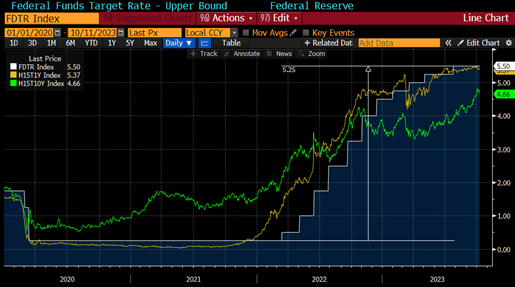Doug Drabik discusses fixed income market conditions and offers insight for bond investors.
I was asked a pretty good question following an internal meeting late last week. The question started out by noting that we have been promoting going longer on the curve for a while now and then asking why we think longer-term rates will come down. Is it possible for shorter-term rates to decline while the 10-year-plus levels stay higher as the economy improves?
First, all things are possible. We find ourselves in very tentative times with volatility and a whole lot of investor uncertainty. When you look at previous Federal Reserve interest-rate-hike cycles, it is common to see short-term rates more sensitive to Fed interest rate hikes versus the longer end of the curve. The gold line in the graph represents the 1-year Treasury and the green line the 10-year
Treasury. The white line or shaded blue area represents the 525 basis points in Fed Funds hikes initiated by the Federal Open Market Committee. When the green and gold line (1yr and 10yr Treasury) cross over, that is when the Treasury curve inverts (short rates move higher than long rates). The one-year Treasury rate follows the Fed interest rate hikes more closely than the 10-year Treasury does. Historically, when the Fed appears to have completed hiking the Fed Funds rate, short-term interest rates begin to fall faster versus the 10-year rates and the curve begins to “normalize” (long-term rates are higher than short-term rates).
One day the market reacts to the idea that interest rates will remain higher for longer. The next day, there is a flight to quality triggered by the Israeli/Hamas conflict which brings rates down. The next day employment figures are healthy but inflation ticks back up suggesting the Fed may have good reason to hike rates one more time. This day-to-day tug-of-war with the market delivers uncertainty which has led to much market volatility.
Since June, long-term rates have elevated faster than short-term rates which is an occurrence known as a bear steepening curve. This is occurring while the Treasury curve is still inverted and rates remain very attractive across the curve. Despite the uncertainty and volatility, what we do know is that interest rates are elevated to levels not seen in 16+ years. Whether short-term rates fall or long-term rates remain higher for longer, at the end of the day, investors’ yield opportunities remain above ordinary. Investors can lock into growth-like returns with individual bonds providing stable cash flows and income streams. Locking in for longer alleviates reinvestment risks associated with buying on the short end. Although the yield curve shape may morph in a couple of different ways, focus on the yield opportunities it is providing investors right now.
The author of this material is a Trader in the Fixed Income Department of Raymond James & Associates (RJA), and is not an Analyst. Any opinions expressed may differ from opinions expressed by other departments of RJA, including our Equity Research Department, and are subject to change without notice. The data and information contained herein was obtained from sources considered to be reliable, but RJA does not guarantee its accuracy and/or completeness. Neither the information nor any opinions expressed constitute a solicitation for the purchase or sale of any security referred to herein. This material may include analysis of sectors, securities and/or derivatives that RJA may have positions, long or short, held proprietarily. RJA or its affiliates may execute transactions which may not be consistent with the report’s conclusions. RJA may also have performed investment banking services for the issuers of such securities. Investors should discuss the risks inherent in bonds with their Raymond James Financial Advisor. Risks include, but are not limited to, changes in interest rates, liquidity, credit quality, volatility, and duration. Past performance is no assurance of future results.
Investment products are: not deposits, not FDIC/NCUA insured, not insured by any government agency, not bank guaranteed, subject to risk and may lose value.
To learn more about the risks and rewards of investing in fixed income, access the Financial Industry Regulatory Authority’s website at finra.org/investors/learn-to-invest/types-investments/bonds and the Municipal Securities Rulemaking Board’s (MSRB) Electronic Municipal Market Access System (EMMA) at emma.msrb.org.
Markets & Investing Members of the Raymond James Investment Strategy Committee share their views on...
Markets & Investing Review the latest Weekly Headings by CIO Larry Adam. Key Takeaways ...
Technology & Innovation Learn about a few simple things you can do to protect your personal information...
